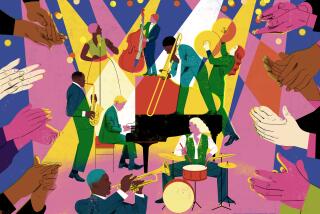Evening Just a Snapshot of Ellington
- Share via
“A Night at the Cotton Club” sounded like a pretty good idea: a “multimedia” evening featuring the live music of Duke Ellington played by a 14-piece band of Los Angeles all-stars, the dancers of the Jazz Tap Ensemble and historic film and audio clips of the Ellington Orchestra in action.
And the performance--at the Carpenter Performing Arts Center in Long Beach--made a spirited effort to deliver on the promise.
The video clips were particularly interesting, reportedly shot at the actual Cotton Club in the late ‘20s. They revealed a young, debonair Ellington, surrounded by his then-relatively-small ensemble, performing for a series of nightclub dance routines. Interestingly, the choreography seemed considerably more dated than the music, which--even at this early stage--possessed the inimitable Ellington sound.
The live performance, however, cast a somewhat different light upon that fabled Ellington sound. The ensemble was led by David Berger, former conductor and arranger for the Lincoln Center Jazz Orchestra. To their credit, Berger’s meticulous transcriptions of such Ellington classics as “Black and Tan Fantasy,” “Solitude,” “Mood Indigo” and “The Mooche” captured every written nuance in the compositions. And the ensemble--which featured such first-rate Southland players as trumpeters Frank Szabo and Ron Stout, saxophonists Jackie Kelso and Don Shelton, trombonist Isaac Smith and vocalist Barbara Morrison--played the arrangements with style and enthusiasm.
But the standard canon on Ellington was that he wrote not for instruments but for individual instrumentalists. A baritone saxophone part, for example, wasn’t conceived simply as an element in a composition but as a specific expression for saxophonist Harry Carney. And it was Ellington’s (and Billy Strayhorn’s) capacity to assemble all the individual skills, sounds and styles of the band’s various players into a cohesive whole that was the essence of Ellington’s creativity.
The Berger ensemble made a game, and often winning, attempt to provide a live feeling for Ellington’s music. And, especially in Stout’s re-creation of the famous Bubber Miley solos, in Shelton’s superb, Barney Bigard-tinged clarinet work, and the utterly unique but highly personable trombone work of Smith, the Ellington resonance became especially strong. At best, however, the performance was still a re-creation--a good re-creation, and one worth doing, but rarely more than a quick snapshot of the lush panorama of Ellington’s incomparable music.
More to Read
The biggest entertainment stories
Get our big stories about Hollywood, film, television, music, arts, culture and more right in your inbox as soon as they publish.
You may occasionally receive promotional content from the Los Angeles Times.










